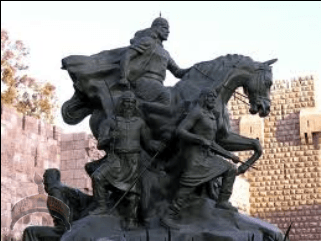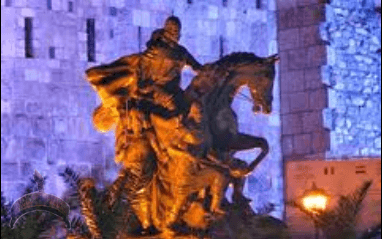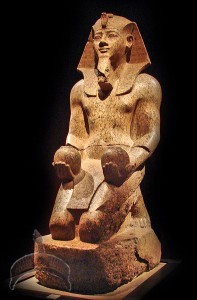15) Sallah Ad Din (Saladin)

Ṣalāḥ ad-Dīn Yūsuf ibn Ayyūb (1138 – March 4, 1193), better known in the Western world as Saladin, was a Kurdish Muslim, who became the first Sultan of Egypt and Syria, and founded the Ayyubid dynasty. He led Muslim and Arab opposition to the Franks and other European Crusaders in the Levant. At the height of his power, his sultanate included Egypt, Syria, Mesopotamia, Kurdistan, Hejaz and Yemen. Under his personal leadership, his forces defeated the Crusaders at the Battle of Hattin, leading the way to his re-capture of Palestine, which had been seized from the Fatimid Egyptians by the Crusaders 88 years earlier. Though the Crusader Kingdom of Jerusalem would continue to exist for a period, its defeat at Hattin marked a turning point in its conflict with the Muslims and Arabs. As such, Saladin is a prominent figure in Kurdish, Arab and Muslim culture. Saladin was a strict adherent of Sunni Islam. His chivalrous behavior was noted by Christian chroniclers, especially in the accounts of the Siege of Kerak, and despite being the nemesis of the Crusaders, he won the respect of many of them, including Richard the Lionheart; rather than becoming a hated figure in Europe, he became a celebrated example of the principles of chivalry.
16)Amenhotep II
Amenhotep II (now and again read as Amenophis II and significance Amun is Satisfied) was the 7th Pharaoh of the 18th administration of Egypt. Amenhotep acquired a limitless kingdom from his dad Thutmose III, and held it by means of a couple of military battles in Syria; nonetheless, he battled substantially less than his dad, and his rule saw the compelling end of dangers in the middle of Egypt and Mitanni, the significant kingdoms competing for force in Syria. His rule is normally dated from 1427 to 1401 BC.
No comments:
Post a Comment